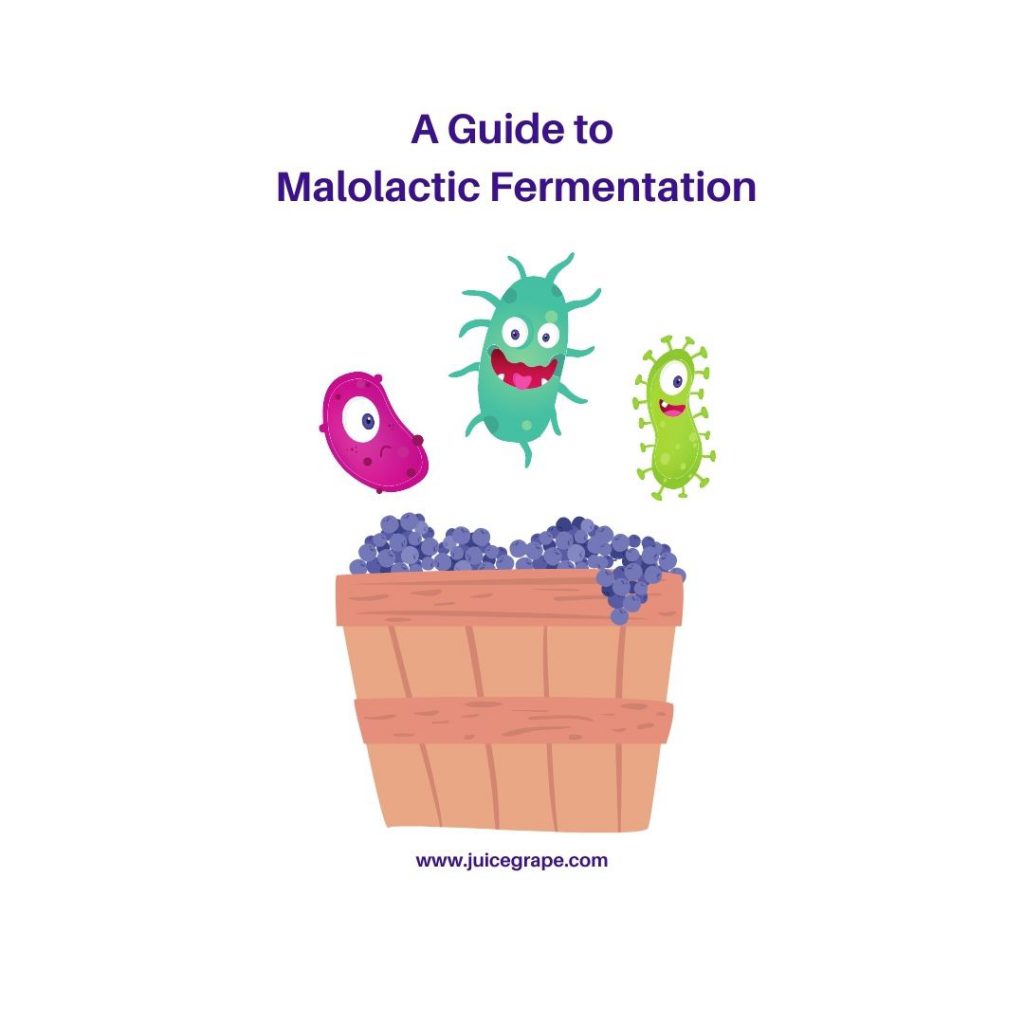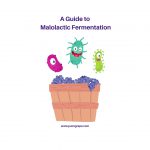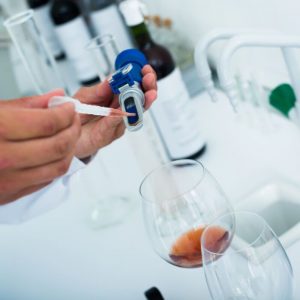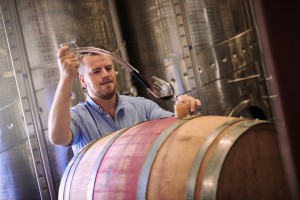A Guide to Malolactic Fermentation
Malolactic Fermentation, also known as Secondary Fermentation or “Malo”, is the process in which Malic Acid in the wine converts to Lactic Acid.

What is Malolactic Fermentation?
As stated above, it is the process in which Malic Acid in the wine converts to Lactic Acid. The primary role of Malolactic Fermentation is to deacidify the wine which affects the sensory aspects of wine, making the mouthfeel smoother and it adds complexity to the flavor and aroma of the wine. The deacidification of the wine happens by converting the harsh diprotic malic acid into the softer monoprotic lactic acid. Nearly all red wines go through Malo while only a few whites, like Chardonnay and Viognier, do. One way to recognize if a wine has gone through Malo is if it has a creamy, buttery mid-palate texture. The buttery flavor comes from diacetyl, a by-product of the reaction.
What is Diacetyl?
Diacetyl is a flavor metabolite produced by lactic acid bacteria known as Oenococcus Oeni. Oenococcus Oeni is the main bacteria responsible for conducting Malo, due to its ability to survive the harsh conditions of wine. It is responsible for the production of the sensory aspects noted above. Malo can happen naturally, though often inoculated with the bacteria culture to jumpstart the process.
When does Malo take place?
Malolactic Fermentation can happen in two different ways, during primary fermentation or after. Amid fermentation, it is Co-Inoculation. After fermentation, it is Post-Fermentation Inoculation. Inoculation that takes place after alcoholic fermentation is the most common practice. When you add bacteria cultures like MBR31 after fermentation is complete, it jumpstarts the Malo process. Co-inoculation takes place at the start of alcoholic fermentation, which allows winemakers to focus on other things such as the improvement of flavor development.
What are the signs that Malo is in progress, and how do I know if it is finished?
The best way to identify malo in progress is bubbles! The malolactic activity can be detected by the presence of tiny carbon-dioxide bubbles. When the bubbles stop, Malolactic Fermentation is complete. This can take anywhere between one and three months.
What are the benefits of each method?
Firstly, the benefits of post-fermentation inoculation include better control of the start time duration of Malo. Lessened biogenic amine production leaves the wine unprotected by sulfite for a limited amount of time. This allows less potential for spoilage by other organisms. It reduces the incidence of excessive volatile acidity and enhances flavor profiles and complexity. The benefits of co-inoculation include lower levels of the inhibitory alcohol that are present at the start of Malo, and no need to apply external heating to the ferment due to the heat generated by the yeast fermentation. This results in faster completion of Malo. This means the wine can have sulfite added earlier and reduces the potential for the growth of spoilage organisms. Finally, a bonus is that bacteria added at the start of the yeast fermentation encounter a nutrient-rich environment.
Need assistance with your winemaking process?
Musto Wine Grape Company is here to help. We offer a wide variety of products and services to help you at any stage in your winemaking journey. Email winemaker@juicegrape.com or call us at (877) 812-1137 to speak with someone who can assist you.
Winemaker Lab Skills Class – October 9th
Musto’s Winemaker Lab Skills Class will be held on Wednesday October 9th at 7:00PM.
Want clarification on TA, pH, and Adjusting Your Wine?
Then this is the class for you!
Professor Frank Renaldi will go over the following lab skills every winemaker needs. It can be difficult to feel comfortable testing your wine. However, Frank has some easy tricks and tips of how to test and adjust your wine.
Class Outline:
- Equipment & Supplies
- Volume Measurements
- Sugar, Content, & Adjustments
- Acidity, Content, & Adjustments
- pH
- Sulfites, Need, & Adjustments
- Blending
- MLF
- Sugar Addition
Sign up today and start sharpening your Winemaker Lab Skills!
Sign up via the website HERE or give us a call at 877-812-1137 to sign up over the phone. We look forward to seeing you in class. Cheers!
The Winemaker’s Think Tank: Vol 33 – “What are Malo lactic bacteria and when do I add them?”
What’s the Winemaker’s Think Tank?
Every Thursday we will post about a few frequently asked questions that our winemaker has answered. If you have a winemaking question you would like to have answered, please email us at support@juicegrape.com and we will try to get into next week’s post. Cheers! 🙂
What are Malo lactic bacteria and when do I add them?
Malo lactic bacteria are a specific strain of bacteria from the Lactobacteriaceae family, typically Oenococcus. These bacteria perform a secondary fermentation, in which they consume malic acid and process it into lactic acid and carbon dioxide. This process is necessary for most reds and sometimes used in Chardonnay production, depending on the winemaker’s stylistic choice. This secondary fermentation processes the more astringent malic acid into the more favorable lactic acid which gives the wine a creamier mouthfeel and more of a mid-palette balance. For Chardonnay it reduces the predominant apple flavor and yields a richer, buttery flavor.
Malo lactic bacteria have a few critical factors to lead to their healthy, successful fermentation. The bacteria favor an environment that has a pH greater than 3.2. They like a warmer temperature environment of above 60°F. They are able to withstand a bit of SO₂, but no more than 50ppm, less than that being ideal. They also have an alcohol tolerance of less than 16%. Each strain of malo-lactic bacteria has its own parameters within which it is most effective. It is important to evaluate these factors when selecting your strain of bacteria to ensure its ability to complete the fermentation.
There are several modes of thought as to the timing of the inoculation of the malolactic bacteria. For the novice winemaker, the inoculation of bacteria after primary alcoholic fermentation is complete may be more advantageous as the will be only one fermentation going on at a time, causing fewer variables to monitor on behalf of the winemaker. Because the yeast has consumed many of the nutrients available to them during primary fermentation, there will be less nutrients available to the bacteria to assist them in conducting malolactic fermentation. A bacterial fermentation nutrient such as Opti-malo Plus should be used to give them the proper nutrition they need to finish their fermentation. Yeast also partially metabolize malic acid throughout their fermentation process; inoculating the bacteria after alcoholic fermentation is complete eliminates the competition for that nutrient for either fermenting agent (yeast or bacteria).
After discussing the benefits of conducting MLF after primary fermentation, there are equally, if not more benefits to co-inoculating the bacteria with the yeast during primary fermentation. It is a popular mode of thinking to inoculate bacteria at 2/3 depletion of Brix levels; the yeast have already passed their exponential growth phase and are on the latter half of their work load. The yeast fermentation will be over the peak in activity which causes dramatic spikes in temperature yet will still be producing some heat to create a nice warm environment for the bacteria to live. With the primary still not yet complete, there will be more nutrients (amino acids, tannins, minerals) to assist the bacteria in their fermentation. This is not to say that the winemaker should not use a malolactic nutrient. The nutrients are still critical in ensuring a through malolactic fermentation. Another benefit of co-inoculation is the aspect of time. By adding the bacteria early on, the malolactic fermentation will complete earlier than if the winemaker were to wait and begin the bacterial fermentation after primary fermentation is complete. This is less time that the wine is without sulfites and at risk of oxidation. As previously mentioned, the yeast also metabolize between 10-40% of the malic acid content within the grapes. By introducing the bacteria earlier, they will have potentially have access to more malic acid, which they will convert to lactic acid, resulting in a creamier, softer mouthfeel. Another benefit of earlier introduction is a lower concentration of alcohol by volume. Most bacteria function best below 16% ABV, so when fermenting a wine that will potentially be high in alcohol, early inoculation may be critical to give the bacteria a head start against the rising alcohol levels. As with most things in life, there is a downside to having a high concentration of lactic acid: lactic acid bacteria. There are bacterial strains that feed on lactic acid and can generate sauerkraut or tart yogurt flavors, regarded as a wine fault.
Another frequently asked question regarding MLF, is how does the winemaker know when it is complete? There are two ways to test for the completion of this fermentation at home. One way is to use a malic acid test to test for any residual malic acid left in the wine. These tests are relatively simple to conduct by the home winemaker, with simple malic acid test kits available for home use for under $50 (includes 10 individual tests). This test is slightly limiting as it will simply test for the presence of malic acid. If the winemaker wants to do a partial MLF on a Chardonnay, for example, this test may not be as useful. Paper chromatography is the preferred method of testing to see if MLF is complete. The kit is more expensive, $90, but will potentially yield hundreds of test. The benefit of this test is the winemaker can then compare the amount of malic vs lactic acid in the wine and see the proportional transition. This will better assist the winemaker in deciding when to stop the fermentation if they wish to do a partial ferment on a Chardonnay. Lastly, for the incredibly detailed, expert home winemaker, they may send a sample to an outside laboratory for analysis. The lab can give them acid quantities present in the wine as well as confirmation of the completion of the fermentation process.
In summary, while there are a myriad of opinions on the timing of the introduction of malo-lactic bacteria, there is no wrong one. The novice winemaker may want to post pone the introduction of the bacteria until primary fermentation is complete to reduce the amount of variables to monitor. The inoculation of the bacteria during the primary fermentation may be more beneficial for the bacteria and the resulting wine, however requires more careful monitoring. As long as the bacteria have proper temperatures and nutrition needs are met, they will conduct a successful secondary fermentation.
We hope this information helps with your winemaking. If you have any follow up questions or winemaking questions in general, please email us at support@juicegrape.com.













Recent Comments